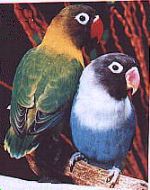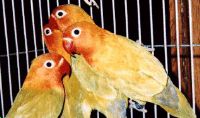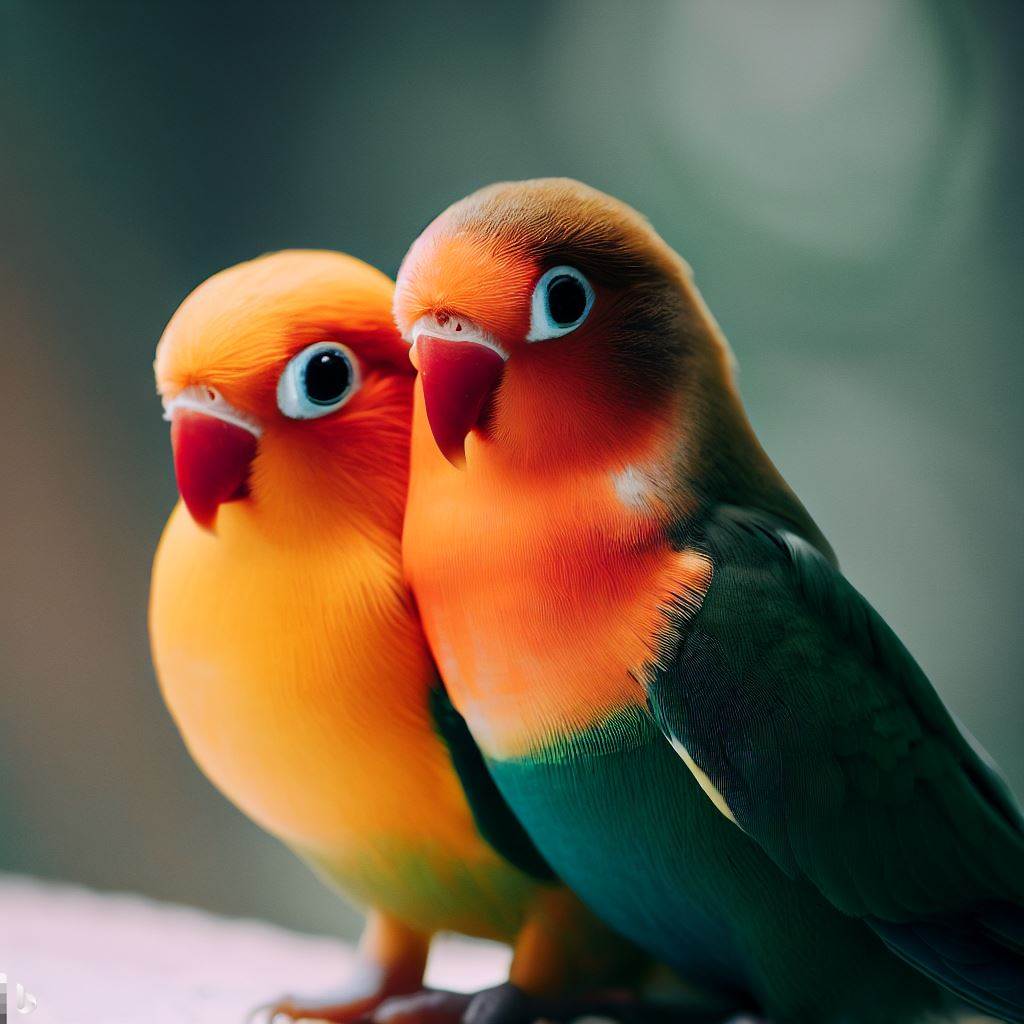Lovebirds are the second smallest species of parrot. Their weight range is 42 to 60 grams. Females tend to be slighter larger than the males. All nine species are in the genius AGAPORNIS. Native to Africa and surrounding islands, many species were imported into the U.S. in large numbers in the late 20 th century. 
Peach Face Lovebirds come in a wide variety of color mutations including normal green, Dutch-Blue, Lutino, Pied, Creamino, Cinnamon, and in combinations of the above. Due to the relative ease of breeding in captivity peach-face are quite common in aviaries and in pet stores.
Color does not reflect on individual pet quality, so choose your bird for its personality. Birds who were hand-fed make excellent pets. Parent raised lovebirds can be difficult to tame. When considering the purchase of a lovebird you should take into account the fact that they are full of energy, and can be quite noisy with their endless chattering and shrill scream, although not anywhere nearly as loud as the larger parrots.
Lovebirds are extremely playful and a joy to watch. With their boundless energy they will swing from toy to toy, hop from perch to perch, never seeming to tire. There is nothing more comical than watching a lovebird do the “birdie splits”, or playing in their water dish, or rolling around on the bottom of the cage with a ball. They enjoy perching on their owners shoulder and playing in their owner’s hair. Hiding in your hair, under your collar, in your pocket, in a empty paper towel roll, etc., is a favorite game.
Affectionate and intelligent, Lovebirds can be taught to give kisses, step-up, wave a foot, and many other tricks. As with most hookbills, Lovebirds also have the ability to learn to whistle and talk. They can speak with clarity and will respond to your voice with eager enthusiasm.
But, beware, Peach-Face Lovebirds can become nippy if they are not raised with consistency and gentle guidance. Fearless by nature, Lovebirds will stand up to other pets in the house so please keep them separated.
Curious by nature, Lovebirds will investigate everything so keep a watchful eye on them at all times. I have a Lovebird who ATTACKED my Blue and Gold Macaw.
By purchasing a young bird you can set the guidelines for appropriate behavior using positive reinforcement. They cost around $50.00 to $75.00 with the rarer color mutations costing more. Don’t let their diminutive size fool you. You get all of the big bird personality in a tiny parrot.
As with all parrots, lovebirds who receive proper care can live many years with their human companions. This must be taken into consideration when purchasing a bird with an average life span of over 10 years. Long term commitment is required .
Lovebirds are popular first time pet birds. They do require a daily portion of fruits, vegetables, pasta, beans, etc., in addition to seed and/or pellets for a balanced diet. Lovebirds will attack spray millet with gusto while ignoring other more nutritious foods, so only offer it as a treat.
Lovebirds need a large clean cage, at least 24 inches wide, that will allow for a lot of activity for these little energetic birds. Purchase the largest cage that your budget and space will allow. Safety is of the utmost importance when purchasing a cage. Think of how much time your bird will be spending in his cage. The cage bar spacing should be every 1/2 inch. Bar spacing, or any other gaps that are too close together can catch toes and beaks causing injuries. Likewise, with spacing that is too far apart. Scroll work is attractive but can pose a safety hazard. Be sure to check for sharp edges and doors that are not easily opened, to prevent accidental escapes.
The addition of several toys will not only help keep these active guys busy but help keep beaks in good condition. Lovebird’s beaks are made of keratin which grows continuously, just like human finger nails. Chewing and destroying wood toys and perches helps to keep beaks trim. Natural perches of varying thicknesses placed at different levels in the cage will allow greater climbing mobility and gives them a choice to select the most comfortable spot to roost.
Love birds are excellent flyers. Keep flight feathers trimmed to prevent accidents and accidental escapes. Nails will need to be trimmed about every 6 to 8 weeks. An annual well bird check is a must for all parrots including Lovebirds. Weigh your bird regularly and record weights so that you will be aware of any weight loss. Watch for signs of illness such as labored breathing, excessive sneezing, sitting puffy, panting, discharge from nares, weight loss, behavior changes, lack of appetite, lethargic, etc. Consult your vet. immediately at the first sign of any unusual symptoms.
A daily cage cleaning is must for a healthy bird. Change the paper in the litter tray daily and wash and disinfect cage weekly. Wash and disinfect perches and toys as needed. Take proper care of your lovebird and you will be rewarded with many years of companionship.
One of the biggest misconceptions about lovebirds is that you must purchase them in pairs. Lovebirds were given their name because 2 birds will bond closely together and ignore everyone else. A single lovebird will form a close bond with his/her owner.
As with all pet parrots, Lovebirds require attention on a regular basis. Lovebirds may become unfriendly if allowed to go extended periods without attention. Supervised time out of the cage is recommend on a daily basis.

Of the 8 remaining species of lovebirds the Masked are the most readily available of the eye-ring species, so named because of the featherless ring around their eyes. They are slightly smaller than Peach-Face Lovebirds. Masked Lovebirds can be purchased at costs equal to Peach-Face.

The eye ring species of lovebirds are not as prolific in captivity as the peach-face. The Nyasa is very rare and breeders have not be very successful establishing this species in captivity. Breeders are having better success with the Black-Cheek , but there numbers in captivity remain relatively small. They tend to be a little shier and less nippy than the peach -faced which makes them wonderful companions.
Other very rare species of Lovebirds are the Madagascar, Red-Faced, and Abyssinian. Habitat destruction and illegal poaching are major causes of species endangerment in the wild. Hopefully, breeders will become successful establishing these and other rare species of birds before their numbers in the wild decrease to extinction.
Peach Face and Masked lovebirds are quite prolific breeders which make them popular for many new breeders. They reach sexual maturity at about 8 months of age, but should not be set up for breeding until they are at least 12 to 15 months old. Nestboxes should be around 7 to 8 inches square. Some sources for nesting material are pine shavings, palm fronds, and willow branches. Some pairs will build elaborate nests while other pairs will not will nest on plain pine shavings. Females can be seen tucking pieces of nesting material into their rump feathers and caring them into the nestbox. The average clutch size is 4 to 5 eggs The incubation period ranges from 23 to 28 days. Most hens will not begin to sit tight until the second or third is laid. Pairs will often go back to nest as soon as the last clutch is pulled or fledged. Young pairs may over breed so be sure to remove nestbox and reduce the amount of daylight hours after the second clutch.

